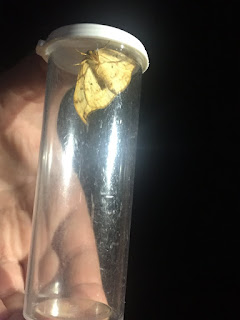Service Learning

On May 27th, we went to Japenese Gulch in Mukilteo for a bug survey lasting from 7 pm to around midnight supervised by Gwen and Tom. This survey is done to identify the types of moths in the area to help inform with visual examples for future students or staff who might do this same survey or want to learn what types of moths are in this area. I helped carry gear to and from the light trapping area and helped to set up. I also caught a few moths in jars for observation/identification. I believe the moth in this picture was a geometrid which was one of the most common we saw there.
After this bug collection survey, I learned about the vast types of moths and bugs that are in my area. Before, I didn't know how different moths could be and the variety of species there are. Many marine organisms rely on bugs like moths as a source of food. Some moths also are known to help pollinate flowers as well. This service learning project contributed moths to Edmonds Community College to be pinned and identified so we have more knowledge for future students who might do this same activity so they can see what species they might find and what they would look like. Before I did this survey I just thought of moths as a nuisance that ate clothing and I didn't really think much of them. I think that our culture has socialized the idea that bugs and moths are annoyances and to be afraid of them or kill them without thinking of the impact on the ecosystem. I don't know why or where this is normalized to think of moths as a bad thing but I think we should instead have society know the importance moths play in their ecosystems and in an environment.I know now that they are an important food source for many organisms and have an important role in their ecosystems. This was the first bug collecting survey they did so I didn't really know what to expect and what we were doing other than identifying bugs. I think it was a good experience and I hope that the information gathered will help future students identify moths and possibly use this information to learn about the ecosystem and other organisms that might live there.
Some questions I have are, how many moths were collected in this survey? How would the data vary if we used a mercury vapor light opposed to the black light used? Where is the information from this survey going? How many more of these surveys will take place and will the location always be the same?


I can't wait to go to more of these especially when the vapor light is working!
ReplyDelete